Bi-fold doors can immediately catch your eye with clean lines, seamless folding, and maximized space. Just before you finalize, a thought should cross your mind – Is there something better?
Bi-fold doors have earned their spot in modern interiors for good reason. However, they’re not the only stars on the stage. And this article dives deep into a range of alternative door solutions.
Why Consider Alternatives to Bi-Fold Doors?
Bi-fold doors are known for their ability to open wide and connect indoor and outdoor spaces. Still, they don’t always provide the best fit for every home.
Space Limitations
- When folded, panels occupy wall space, limiting furniture placement or wall décor.
- Bi-folds often need deeper thresholds, posing tripping hazards or complex transitions.
Aesthetic Preferences
- Multiple frames and hinges can break up sightlines in minimalist or Scandinavian interiors.
- While aluminum and timber options exist, customization is often pricier and less seamless.
Budget Constraints
- In 2025, bi-fold doors range from £2,500 to £7,000, with installation adding £550 to £1,500.
- Custom glazing, multi-panel configurations, and reinforced tracks can greatly push the price.
Hinge Issues
- Salt buildup can corrode tracks and hinges in coastal regions, demanding weekly rinsing.
- Panels may sag over time due to improper high alignment, especially in lower-end models.
Maintenance Considerations
- Dirt and debris can jam folding mechanisms, requiring frequent vacuuming and lubrication.
- Multi-point locks often require periodic lubrication alongside inspection to prevent sticking.
Sliding Doors
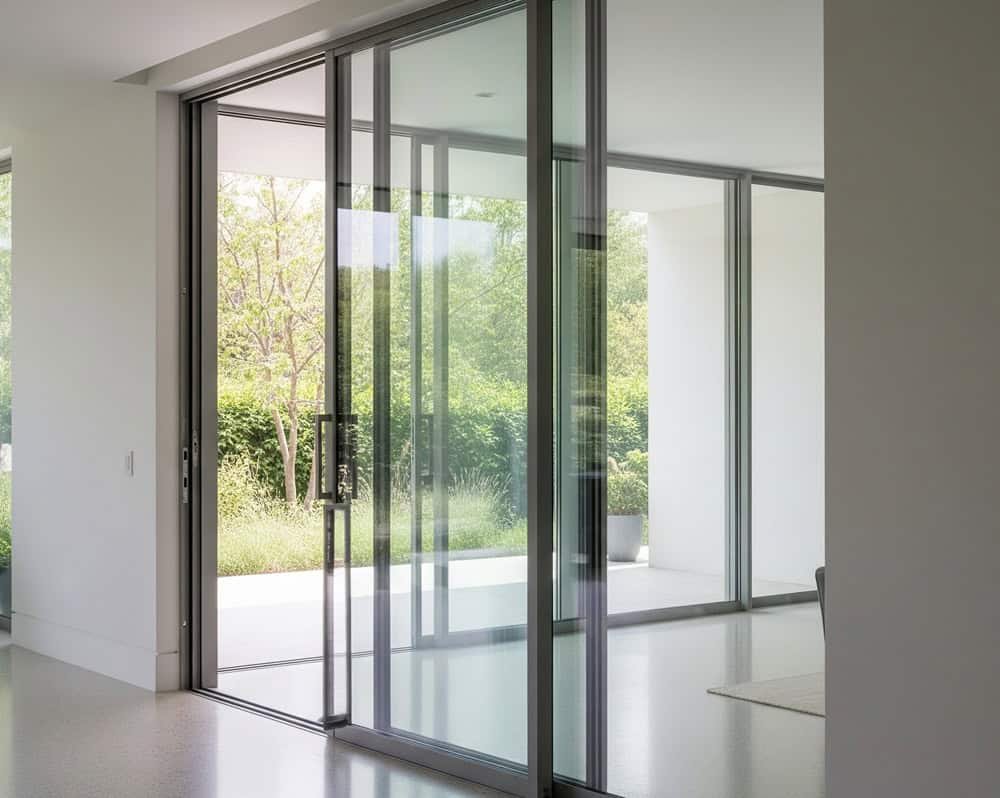
Sliding doors have long been a favorite in residential and commercial architecture. It offers a sleek and functional alternative to bi-fold systems.
Sliding doors operate on a horizontal track system, either top-hung or bottom-rolling. One or more panels glide parallel to the wall, eliminating the need for swing clearance.
This mechanism allows for a seamless transition between rooms or from indoor to outdoor spaces, especially patios, balconies, and garden areas.
Benefits
- Available in glass, wood, aluminum, and uPVC.
- Sliding doors don’t require swing space, making them ideal for compact layouts.
- Designed for wide openings, such as patios or garden entrances.
- Modern systems include soft-closers and dampeners for effortless movement.
- Customizable with frameless panels, tinted glazing, or minimalist profiles.
Downsides
- Only half of the opening is usable at a time, restricting airflow compared to bi-fold or French doors.
- Sliding doors can get expensive due to reinforced tracks, custom glazing, and multi-panel configurations.
Best Uses
- Smaller spaces where swing clearance is limited.
- Homes prioritizing natural light without compromising on layout.
- Modern interiors seeking clean lines and open flow.
They’re especially effective in –
- Studio apartments.
- Kitchen-to-patio transitions.
- Balcony access in high-rise buildings.
French Doors

French doors are a timeless architectural feature that blends elegance with functionality. Renovating a heritage home or adding charm to a modern space – they offer a graceful alternative to bi-fold doors.
French doors are hinged double doors of wood, aluminum, or fiberglass frames with glass panels. They open outwards or inwards, depending on the design, and are often used to connect indoor living areas to patios, gardens, or balconies.
They were designed to maximize natural light before the advent of electricity. Modern versions include inswing, outswing, and sliding French doors, with options for decorative grilles, sidelights, and transoms.
Benefits
- French doors evoke classic sophistication for traditional, colonial, or vintage interiors.
- Available in styles like Victorian, Craftsman, and Prairie with customizable decorative glass.
- Both panels can open fully, allowing maximum airflow for cross-ventilation.
- Large glass panes flood interiors with sunlight, reducing reliance on artificial lighting.
- Energy-efficient models with low-E glass and argon-filled panes offer insulation.
Downsides
- Hinged operation requires clearance on both sides.
- Not ideal for tight spaces or narrow corridors.
- Wooden or aluminum doors can become heavy.
- Installation may involve structural adjustments.
Best Uses
- Classic or vintage-style homes seeking architectural charm.
- Living rooms, dining areas, or master suites where elegance and openness are desired.
- Patio or garden access, offering a seamless indoor-outdoor transition.
They’re especially popular in –
- Restored heritage homes.
- Luxury apartments with balconies.
- Country cottages and farmhouse-style renovations.
Pocket Doors
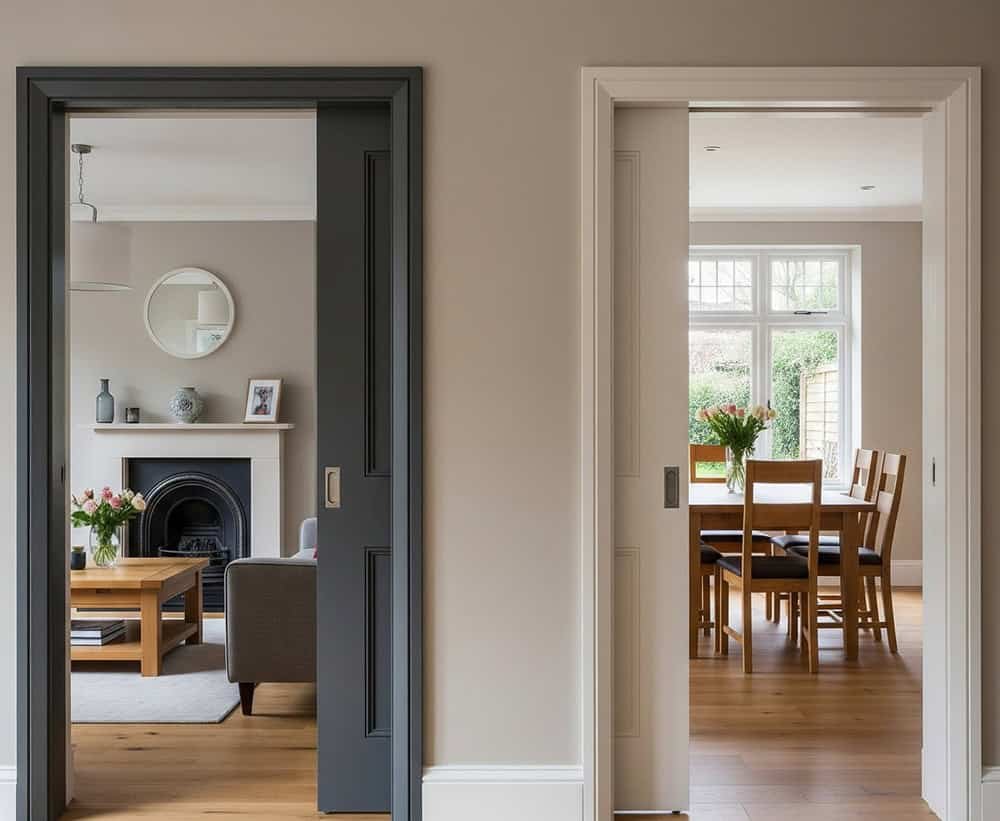
They’re a clever architectural solution by combining form and function in homes where every square foot matters. Pocket doors are sliding doors that retract into a hidden cavity within the adjacent wall.
Unlike barn or bypass doors, they don’t slide along the outside of the wall—they vanish inside it, for a seamless transition between spaces. It operates on overhead tracks or floor guides based on design.
Benefits
- Save up to 10 square feet of floor space compared to hinged doors.
- Ideal for tight layouts, such as small bathrooms or narrow hallways.
- Allow for furniture placement closer to walls without obstruction.
- Offer a clean, unobtrusive aesthetic, especially frameless or flush models.
- Blend into walls for a streamlined look, perfect for modern interiors.
- Available in various (wood, glass, metal, and even custom) finishes.
Downsides
- Require modifying the wall to create a cavity.
- Not suitable for load-bearing walls without structural reinforcement.
- May involve rerouting plumbing or electrical wiring.
Best Uses
- Small spaces like powder rooms, closets, and laundry areas.
- Homes with limited swing clearance.
- Design-forward interiors seeking a sleek, integrated look.
They’re especially effective in –
- Studio apartments.
- Jack-and-Jill bathrooms.
- Transitional spaces like home offices or pantries.
Accordion Doors
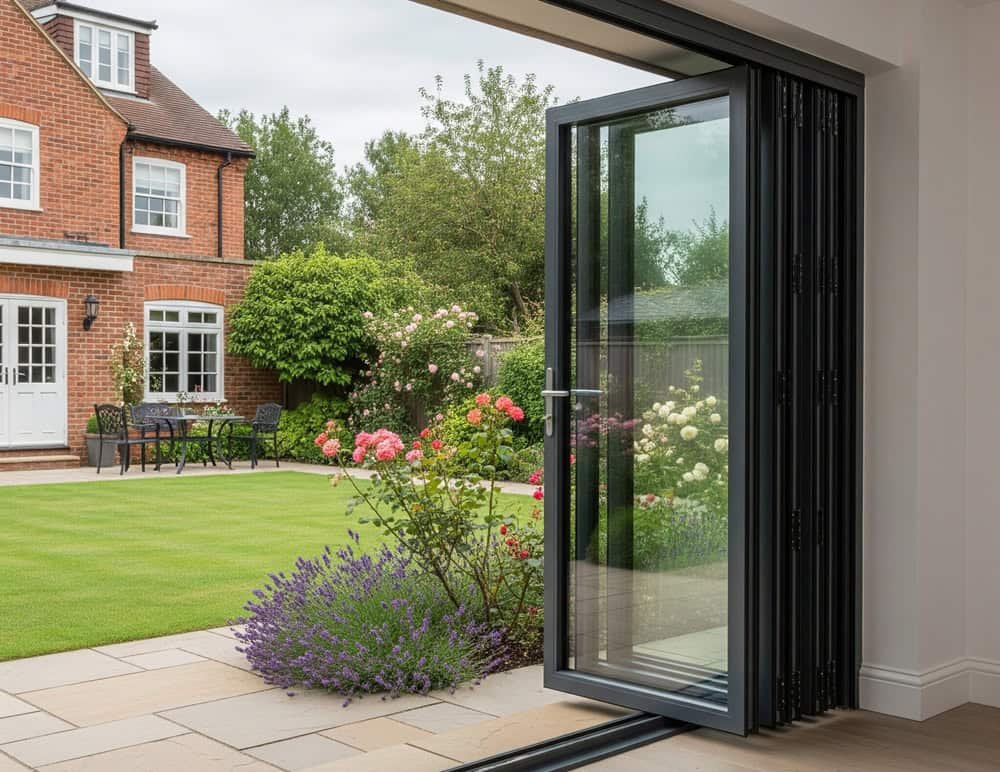
Accordion doors are a flexible and budget-friendly alternative to bi-fold doors. They go exceptionally well with interior spaces where maximizing functionality and minimizing footprint is key.
Accordion doors are made of interconnected panels that fold into themselves along a track. It’s much like bi-fold doors, but typically with lighter frames and more compact stacking.
They operate on top-mounted or floor-mounted tracks with rollers. Panels fold like a concertina (neatly stacking on one or both sides). They have uses in room dividers, closet doors, or temporary partitions.
Benefits
- Entry-level models start under $100 at retailers like Wayfair.
- Lightweight construction makes them DIY-friendly, with minimal tools required.
- Ideal for quick renovations or rental properties.
- Compact folding requires no swing space.
- Great for closets, pantries, laundry rooms, and tight corridors.
- Can span wide openings without needing structural changes.
- Available in wood, vinyl, aluminum, PVC, and fabric.
Downsides
- Lightweight panels may warp or tear over time.
- Hinges and tracks can wear down with frequent use.
- Thin materials offer minimal soundproofing.
- Not ideal for exterior use or rooms requiring privacy.
Best Uses
- Interior spaces like closets, small offices, laundry rooms, and pantries.
- Temporary partitions in studios, classrooms, or shared workspaces.
- Budget-conscious renovations where style and flexibility matter more than durability.
They’re especially effective in –
- Compact homes.
- Rental units.
- Multi-purpose rooms.
Panel Doors
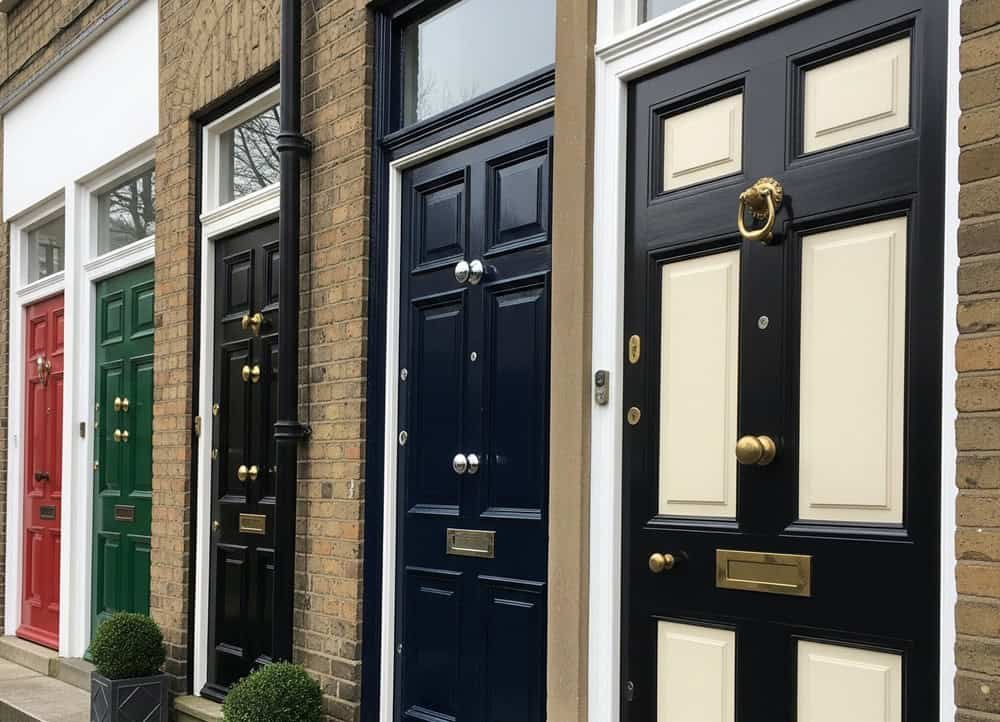
Panel doors are a timeless version with a blend of durability, elegance, and versatility. Whether you’re renovating a heritage home or designing a cozy bedroom retreat, panel doors provide a solid alternative to bi-fold systems.
Panel doors are swing-style doors constructed from one or more flat or raised panels. The panels remain framed by vertical stiles and horizontal rails. Aside from solid wood, the door can be of MDF, fiberglass, steel, or glass inserts, depending on the design and function.
Standard configurations include single-, two-, four-, and six-panel designs. Panels may be flat, raised, or recessed, offering stylistic variety. They primarily operate on hinges, swinging inward or outward depending on the layout.
Benefits
- Panel doors are iconic in colonial, Victorian, craftsman, and shaker-style homes.
- Their textured surfaces and moldings add depth and character.
- Available in arch-top, French panel, and shaker variants for tailored aesthetics.
- Solid wood and composite panel doors offer superior thermal and acoustic insulation.
- Can reduce energy costs by minimizing heat transfer and drafts.
- Can be tailored to specific dimensions, finishes, and panel layouts.
- Materials include oak, pine, MDF, fiberglass, and steel.
- Options for decorative glass inserts, mirror panels, or chalkboard surfaces.
Downsides
- Hinged operation demands clearance for opening to limit placement.
- Not ideal for narrow hallways or compact apartments.
- Can interfere with furniture layout or wall-mounted fixtures.
Best Uses
- Bedrooms and bathrooms where privacy and insulation are essential.
- Home offices or libraries requiring sound dampening.
- Traditional or transitional interiors seeking architectural charm.
They’re especially effective in –
- Detached homes with spacious layouts.
- Renovations of historic properties.
- Rooms with controlled climate zones.
Pivot Doors
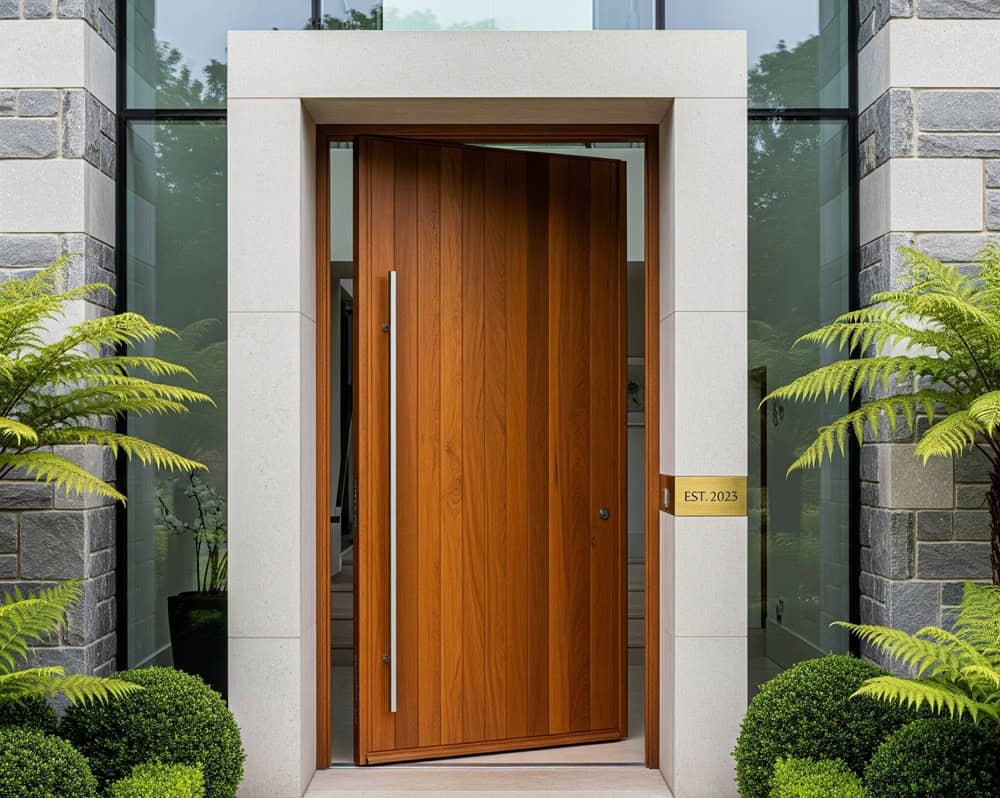
Pivot doors are designed not just to open a space, but to transform it. With their unique mechanics and bold aesthetics, they’re a favorite among designers looking to make a statement in modern homes.
Pivot doors rotate on a central vertical axis. It’s supported by pivot hinges mounted at the top and bottom of the door rather than traditional side hinges. This offset pivot point allows the door to swing open in a smooth, gliding motion.
The pivot point is typically placed a few inches from the edge, dividing the opening into active and inactive zones. They can swing inward, outward, or both, depending on hinge placement.
Benefits
- Frameless or flush designs offer a minimalist aesthetic.
- Concealed hardware enhances the clean lines and architectural appeal.
- Pivot hinges distribute weight vertically for heavier materials.
- No sagging or warping when properly engineered.
- Perfect for grand entrances, open-plan interiors, or indoor-outdoor transitions.
- Can be paired with glass walls or pivoting partitions for dramatic effect.
Downsides
- Custom sizing, premium materials, and specialized hardware drive up costs.
- Installation often requires structural reinforcement and professional expertise.
- Though visually compact, pivot doors need clear space on both sides to operate.
Best Uses
- Modern or contemporary homes with bold design elements.
- Large entrances, such as foyers or patio transitions.
- Open-concept layouts where flow and scale matter.
- Design-forward renovations seeking a unique focal point.
They’re especially popular in –
- Art galleries and boutique hotels.
- Luxury residences.
- Coastal homes with expansive views.
Auto-Closing Doors (Automatic Doors)
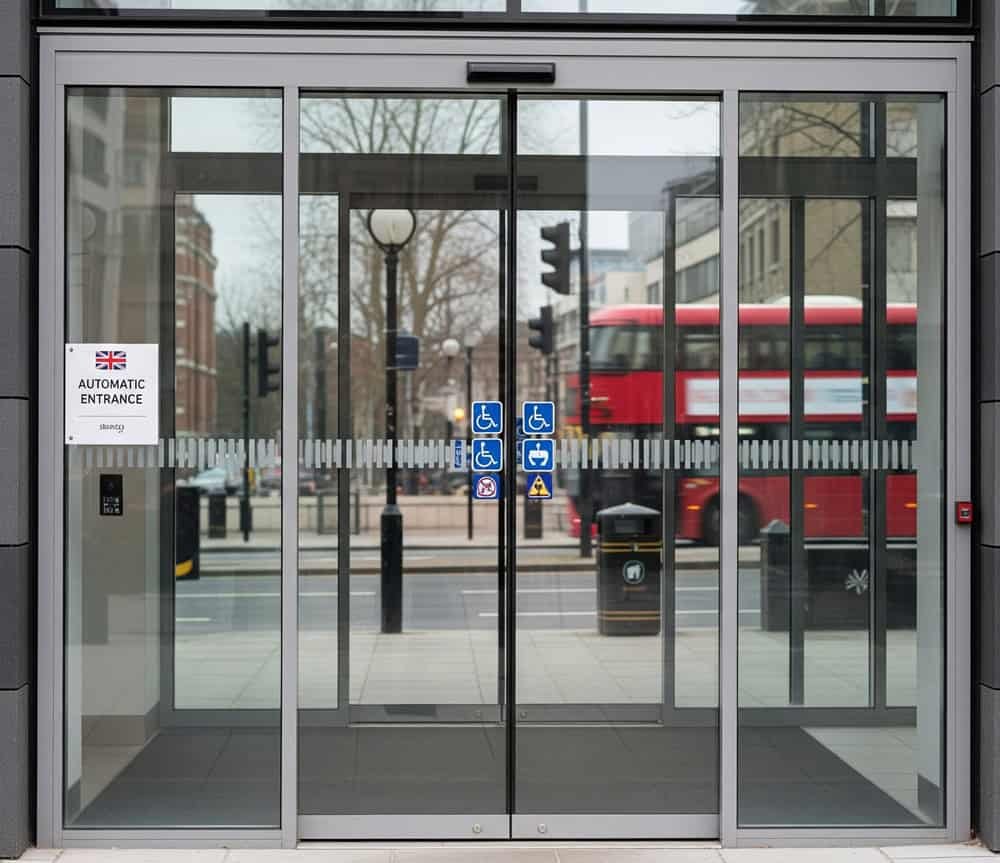
Automatic doors were once reserved for commercial buildings. They’re now making their way into modern homes, offering a blend of convenience, accessibility, and futuristic design.
Auto-closing doors automatically shut after being opened, using mechanical, hydraulic, or electro-mechanical systems. While commonly seen in malls, hospitals, and airports, they’re increasingly adopted in smart homes and accessibility-focused renovations.
They operate via motion sensors, push-button systems, or remote controls. A separate version can be sliding, swinging, or revolving. It’s often integrated with smart home systems for voice/app control.
Benefits
- Reduces touchpoints, enhancing hygiene—especially in kitchens or bathrooms.
- Compliant with ADA and universal design standards.
- Beneficial for elderly or disabled individuals who may struggle with manual doors.
- Can be paired with low-energy operators for gentle opening and closing.
- Enhances independence for users with mobility challenges.
- Seamlessly integrates with smart home systems like Alexa, Google Home, or Apple HomeKit.
- Available in frameless glass, aluminum, or timber finishes.
- Adds a futuristic touch to interiors, especially in minimalist or high-tech designs.
Downsides
- Needs a dedicated power supply or battery backup.
- Requires professional setup, especially for concealed or sliding systems.
- Maintenance includes sensor calibration, motor servicing, and software updates.
- Vulnerable to power outages unless equipped with a manual override.
- May involve rewiring or structural changes, especially in retrofits.
Best Uses
- Smart homes seeking automation and voice control.
- High-traffic areas like kitchens, hallways, or entryways.
- Accessibility-conscious spaces, such as elder care facilities or inclusive housing.
- Design-forward interiors where technology meets aesthetics.
They’re especially effective in –
- Tech-enabled apartments.
- Modern villas with open-plan layouts.
- Homes with multigenerational residents.
From sleek sliding to elegant French doors, there’s no shortage of exciting alternatives to bi-fold doors. Each option carries its strengths in design, functionality, and practicality. While bi-fold doors remain a stylish and functional favorite, they’re not the only way to elevate your living space.
Choosing the right door doesn’t revolve around the design alone. It must align with your home’s layout, daily routines, and the atmosphere you want to create. Whether you’re crafting cozy nooks or sweeping open-plan transitions, there’s a door that perfectly frames your vision.
Contact Door Engineers who offers commercial aluminium doors in Birmingham for more details.
Frequently Asked Questions
Yes. Sliding doors are one of the most popular replacements for bi-folds. They require less clearance than swinging doors while offering larger glass panels for better views. However, they don’t open the full width like bi-folds.
Absolutely. Pocket doors are a top choice for compact layouts. They slide into the wall, freeing up floor and wall space. It introduces a clean, modern look while providing full access without obstruction.
While still functional, bi-fold doors are no longer the default choice. Homeowners now favor slim-framed sliding doors for better views. The same goes for pivot doors for dramatic entrances and pocket doors for space-saving efficiency.
Yes. Mixing door styles (sliding for patios, panel for bedrooms, pocket for bathrooms) can enhance functionality with cohesion. Use consistent materials, finishes, or hardware to unify the look.
Solid panel doors, fiberglass French doors, and high-performance sliding doors with low-E glass and thermal breaks offer excellent insulation. Pocket and accordion doors typically provide less thermal protection, making them better suited for interior use.

